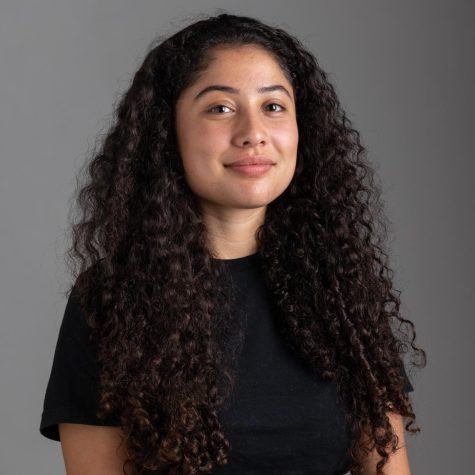




Oct 28, 2022
Members of SF State’s Cinema Collective reflect on horror films in the spirit of Halloween. Its members, Maureen Villanueva and President Paulo Campos speak on the social issues and methods of production as well as reminisce on their own familial experiences with horror and Halloween.
[Halloween music]
Isabella: Boo! Did I scare you? Happy Halloween gators! This is Isabella Vines, diversity editor of Golden Gate Xpress.
Matthew: And I’m Matthew Cardoza, Xpress copy editor. Welcome to an Xpress Pod Halloween special. I hope you’re ready for a scary good time!
Isabella: In the spirit of Halloween, we’re going to talk horror movies.
Isabella: SF State has a film club on campus called Cinema Collective that focuses on talking, watching and making films. We sat down with some of its members, Maureen Villanueva and President Paulo Campos, to get a perspective on horror films and Halloween.
So let’s get into it.
Isabella: To start us off, what are you doing for Halloween?
Matthew: I’m just going to take it easy and have a horror movie marathon… What are you going to do?
Isabella: I’m actually thinking about doing the same thing. After going through our interviews, we found that inspirations for horror movies actually come from personal places.
Matthew: According to Maureen and Paulo, a lot of the ideas behind horror films derive from scary stories they were told when they were kids…
[archival audio begins]
“There’s this one particular story about kind of like a Condor who, you know, when we would do something bad, a feather would appear on the window and that would be a bad sign.”
Matthew: According to the California Department of Parks and Rec, a Condor is a sacred bird to the Inca and was greatly admired for flying long distances. They believed it was the messenger of the skies and heavens as well as associated with death and mourning as well as rebirth and renewal.
Isabella: Wow, that sounds really cool! What other monsters did they bring up?
Matthew: Maureen brought up a horrific monster rooted in Filipino folklore, just seeing images of it online brought shivers down my spine…
“There’s this mythological creature called an Aswang, which is basically like this human-bat thing. Like half the body comes off and it can fly and like kill you and attack you. It’s pretty scary growing up hearing that kind of story. Like they come out late at night to haunt little babies, little children, just menacing, you know?”
Isabella: According to a CBC article, Aswang is a creature greatly recognized within Filipino folklore. This creature is known as a shapeshifter that morphs into many monsters we recognize such as vampires, ghouls or werewolves.
Matthew: Ok… now that is super scary.
Isabella: I know right! So switching things up let’s talk costumes. In recent years, there has been a lot of talk around wearing cultural clothing for Halloween in relation to appropriation and appreciation. For example, dressing up as Native Americans, wearing hijabs or wearing kimonos as though they are actually “costumes.”
Matthew: Seeing people wear that, even in like more modern times, is definitely insulting. Because cultural clothing often represents tradition and history that’re meaningful to their respective cultures and communities. Wearing cultural dress without learning about its history is a dangerous display of ignorance. What does the Cinema Collective think about this issue?
Isabella: They believe that as long as costumes are worn as a form of representation as opposed to appropriation, then it should be okay.
“There’s a spectrum of people who don’t take offense to some wardrobe as long as it’s respected.”
“I think to me, cultural appropriation is just wrong. I don’t think you should do it. I think in terms of Halloween, or like in filmmaking, showing it in film. I think it’s okay to show it if you’re going to be educating people about it or if you’re gonna be like, critiquing or criticizing it…”
Isabella: And with that, we’re going to take a quick break.
Matt: Support the Golden Gate Xpress’ work by signing up for our newsletter, following us on Instagram and Twitter @GGXnews, and visiting the website: https://goldengatexpress.org/.
Our sister publication, Xpress Magazine, just released its second issue of the semester. Check it out online at xpressmagazine.org or grab a print edition throughout campus.
Did you know we recently launched a new podcast with Xpress Magazine? Listen to the first episode of “Between the Issues” on our website https://goldengatexpress.org/.
Isabella: And… we’re back. So… what are some of your favorite horror movies?
Matthew: My favorites are “Scream,” “Alien” and “Hereditary.” Those are definitely in my top five.
Isabella: Really? I love those too! But, after talking with Cinema Collective, we’ve come to find there are many other underlying issues in the production of our favorite horror films, like the representation of women.
“I think a big problem in horror films is the objectification of women. Oftentimes you seem them depicted as completely naked, completely vulnerable and being taken advantage of. I think that’s something in the horror genre that should be addressed.”
“There’s the virgin trope, there’s the ditzy blonde who’s a horror trope. And ultimately, I think it’s just to shit down on women. It’s supposed to prove that “oh, if you don’t save yourself for God,” “oh if we don’t chase men, you’re gonna be the final girl” and “if you’re a dumb girl who lie chases around sex, you’re gonna die.” Like I think that’s the messed up part. Like it sends the wrong message, you know what I mean? Like I don’t think that’s a healthy way of representing women.
Isabella: In addition, they also feel that minorities are misrepresented within films as well.
“One thing I kind of noticed a lot that is very problematic is that for Latinos, especially since our cadences and our pace of talking is very infatuated to be fast and also were kind of typically made as the joke character in those stories… Someone who’s in tune with nature and knows the answers and is going to give you guys the answers to combating some horrible creature in the film or trying to solve a ghost problem.”
Isabella: And in what ways do they think Hollywood could improve these issues with horror films?
Matthew: They mentioned that more rightful representation could be a start…
“It’s the fact that at least from my background and seeing others who are in that same boat in terms of representation and how we feel we’re being perceived as could do a lot better… and it’s up to us to write and be the ones to show ourselves on the big screen.”
“I think now we’re entering a new modern era with more powerful film, female filmmakers coming out writing great stories, great characters who are strong and independent. I think we’re somehow entering a good direction.”
Isabella: Are they working on any horror films themselves?
Matthew: Yes they are…. Paulo has been working hard for a while now, making his first-ever movie.
[interview audio begins]
“I’m actually working on my first directorial debut short film…. It’s called Amaru… It’s basically about a Latino college filmmaker, who is at odds against his producer but when the producer starts making changes to his films, he starts getting disrupted and eventually haunted by Amaru, his film creature. And so he has to sort of figure out how to not just extinguish Amaru from his life but also what it means to be a Latino filmmaker right now.”
[interview audio ends]
[halloween music]
Isabella: And that’s all for today! This is Isabella Vines, diversity editor.
Matthew: And Matthew Cardoza, copy editor.
Thank you so much for listening to our Halloween special.
We will return to our regularly scheduled episodes of Gatortalk next week, so keep an ear out.
And with that, Happy Halloween gators!


